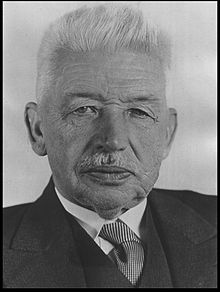Ludwig Aschoff
Ludwig Aschoff | |
|---|---|
 Karl Albert Ludwig Aschoff | |
| Born | January 10, 1866 |
| Died | June 24, 1942 (aged 76) |
| Nationality | |
| Known for | Cardiac pathology, atrioventricular node, Aschoff bodies |
| Scientific career | |
| Fields | Pathology |
| Institutions | University of Göttingen University of Marburg University of Freiburg |
Karl Albert Ludwig Aschoff (January 10, 1866 – June 24, 1942) was a German physician and pathologist. He is considered to be one of the most influential pathologists of the early 20th century and is regarded as the most important German pathologist after Rudolf Virchow.
Aschoff was born in Berlin, Prussia. He studied medicine at the University of Bonn, University of Strasbourg, and the University of Würzburg. After his habilitation 1894, Ludwig Aschoff was appointed professor for pathology at the University of Göttingen in 1901. Aschoff transferred to the University of Marburg in 1903 to head the department for pathological anatomy. In 1906, he accepted a position as ordinarius at the University of Freiburg, where he remained until his death.
Aschoff was especially interested in the pathology and pathophysiology of the heart. He discovered nodules in the myocardium present during rheumatic fever, the so-called Aschoff bodies. Aschoff's reputation attracted students from all over the world, among them Sunao Tawara. Together they discovered and described the atrioventricular node (AV node, Aschoff-Tawara node). Numerous travels abroad, to England, Canada, Japan, and the US led to many research connections, whereas the trips to Japan proved to be especially productive. In the early 20th century, 23 of 26 Japanese pathological institutes were headed by students of Aschoff.
Aschoff's popularity in Japanese medicine had its roots in the Germany-Japan Alliance. Among his pathological studies was also the issue of racial differences. "Pathology of constitution" invented by him became a special branch of research of National Socialist doctors under the name of "military pathology". Franz Buechner is reported to be Aschoff's most prominent pupil.
His grave is preserved in the Protestant Friedhof I der Jerusalems- und Neuen Kirchengemeinde (Cemetery No. I of the congregations of Jerusalem's Church and New Church) in Berlin-Kreuzberg, south of Hallesches Tor.
References
- Keitel, W (2008). "[The pathologists: Aschoff, Klinge and Gräff]". Zeitschrift für Rheumatologie. 67 (2): 165–71. doi:10.1007/s00393-007-0255-4. PMID 18309501.
{{cite journal}}: Cite has empty unknown parameters:|laydate=,|laysummary=, and|laysource=(help); Unknown parameter|month=ignored (help)
See also
- 1866 births
- 1942 deaths
- German pathologists
- German scientists
- Pathologists
- People from Berlin
- People from the Province of Brandenburg
- University of Bonn alumni
- University of Strasbourg alumni
- University of Würzburg alumni
- University of Göttingen faculty
- University of Marburg faculty
- University of Freiburg faculty
